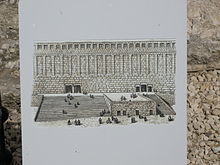| Revision as of 21:30, 28 February 2011 editDr. Blofeld (talk | contribs)Autopatrolled, Extended confirmed users, Pending changes reviewers, Rollbackers, Template editors636,183 edits add infobox and map← Previous edit | Revision as of 21:33, 28 February 2011 edit undoSupreme Deliciousness (talk | contribs)Extended confirmed users, Pending changes reviewers, Rollbackers22,574 edits Its not located in Israel.Next edit → | ||
| Line 25: | Line 25: | ||
| | address = | | address = | ||
| | location_town = ] | | location_town = ] | ||
| | location_country = |
| location_country = | ||
| | iso_region = | | iso_region = | ||
| | coordinates_display = | | coordinates_display = | ||
Revision as of 21:33, 28 February 2011
| This article needs additional citations for verification. Please help improve this article by adding citations to reliable sources. Unsourced material may be challenged and removed. Find sources: "Huldah Gates" – news · newspapers · books · scholar · JSTOR (December 2009) (Learn how and when to remove this message) |
| Hulda Gate | |
|---|---|
 The eastern set of Hulda gates as it stands today. The eastern set of Hulda gates as it stands today. | |
 | |
| General information | |
| Town or city | Jerusalem |

The Huldah Gates are the two sets of now-blocked gates in the Southern Wall of the Temple Mount, situated in Jerusalem's Old City. The western set is a double arched gate (the double gate), and the eastern is a triple arched gate (the triple gate). Each arch of the double gate led into an aisle of a passageway leading from the gate into the Mount, and to steps leading to the Mount's surface; when the al-Aqsa Mosque was built, the old steps were blocked, and the eastern aisle lengthened so that new steps from its end would exit north of the Mosque. The triple gate is similar, though the longer aisle is to the west, and its third aisle, on the east, forms the western boundary of the vaulted area known as Solomon's Stables.
Name
The name "Huldah gates" (Shaarei Chulda) is taken from the description of the Temple Mount in the Mishnah (Tractate of Midot 1:3). Accepted opinion amongst scholars is that the Mishna's description refers to the sanctified area of the Temple Mount in the Hasmonean period. Therefore, calling the gates found in the current southern wall "Huldah" would be an anachronism, as the base of that wall is part of Herod's post-Hasmonean extension of the Temple Mount.
Two possible etymologies are given for the name: "Huldah" means "mole" or "mouse" in Hebrew, and the tunnels leading up from these gates called to mind the holes or tunnels used by these animals. Alternatively, in a possible folk etymology, the First Temple prophetess Huldah was said to have held court in this area and, indeed, her tomb was placed here by some as well.
Past excavations
The 19th century excavations of the area by Charles Warren discovered an erratic series of passageways under the triple gate, some leading below the wall and beyond the Mount's southern edge. The purpose and age of these passages are unknown, and more recent archaeologists have not been allowed to investigate due to the political volatility of the site. The passageways from both gates are now used by the waqf as mosques.
Gallery
-
 Pilgrim steps as they approach the Double Gate
Pilgrim steps as they approach the Double Gate
-
 Triple Gates
Triple Gates
-
 Visible portion of Double Gate
Visible portion of Double Gate
-
Double Gate
-
Triple Gate
-
 Triple Gate
Triple Gate
-
 Triple Gate
Triple Gate
-
 Triple Gate in 1855 photo
Triple Gate in 1855 photo
References
- Encyclopædia Judaica (ed. 1972), vol. 15, pp. 963-4
- 2 Kgs 22:14-20
- Encyclopedia Judaica (ed. 1972), vol. 8, p. 1063
- (Tos. Neg. 6:2)Encyclopædia Judaica (ed. 1972), vol. 9, p. 1553
- Encyclopædia Judaica (ed. 1972), vol. 9, p. 1525
31°46′33.4″N 35°14′11.8″E / 31.775944°N 35.236611°E / 31.775944; 35.236611
Categories: